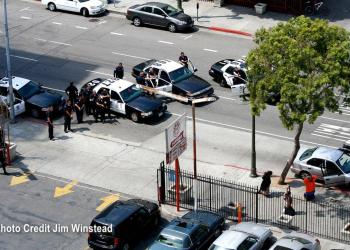
Ninth Circuit Limits High-Risk Vehicle Stops: New Potential Liability Risks for Police
Having cause to believe a vehicle is stolen, or even that it is “cold-plated” (i.e., using a license plate not assigned to that vehicle), is insufficient by itself to justify subjecting the vehicle’s occupants to a high-risk felony vehicle stop (i.e., a “hot-stop”) absent an articulable reason to believe the occupants are armed or otherwise dangerous. Officers are subject to potential civil liability for conducting a high-risk vehicle stop based upon nothing more than a reasonable suspicion (or even probable cause) that the vehicle was stolen, absent a reason to believe the occupants are armed and/or dangerous.
On June 16, 2019, Hasmik Chinaryan, while innocently driving home from a family Father’s Day celebration with her teenage daughter and a friend in the car, suddenly became the target of a high-risk felony traffic stop by a dozen Los Angeles Police Department officers plus a helicopter unit. The officers were acting upon information that a black Chevrolet Suburban limousine had been stolen three days earlier. The stolen Suburban was equipped with a “LoJack device.” The day after it was stolen, LAPD’s Foothill Division detected a signal from that device. Two patrol officers located the LoJack signal’s approximate source, which the court noted are not as accurate as GPS. The officers, however, were confident that the signal was originating from within a specific two or three businesses in an industrial area on Glenoaks Boulevard, which was known to have many “chop shops,” where stolen vehicles are taken apart and sold for parts. But because it was a weekend and the businesses were closed, they decided to wait until Monday the 16th to continue the investigation.
The car Chinaryan was driving on the 16th was a black Suburban limousine which, although three years newer (2018 vs. 2015) than the stolen Suburban, looked very similar. Chinaryan in her Suburban was spotted by a police sergeant about half a mile from where the stolen Suburban’s LoJack signal had been detected the day before. Thinking, “What are the chances?” the sergeant did a radio check on Chinaryan’s license plate number, requesting DMV information. The communications unit informed him that the license plate belonged to a Dodge Ram and gave him information regarding the registered owner, which was someone other than Chinaryan. The Dodge Ram had not been reported stolen.
Based upon this information, the sergeant suspected that Chinaryan’s Suburban was “cold-plated” with a license plate other than the one registered with DMV, and thus likely stolen. He called for backup, including a helicopter unit. While following Chinaryan for the next 10 minutes, it was noted that she neither exceeded the speed limit nor drove evasively, following all traffic laws. And while it was still daylight, the sergeant could not see the vehicle’s occupants from behind due to its heavily tinted windows. The two officers who had responded to the LoJack signal report two days earlier, driving toward the location from the opposite direction, could see Chinaryan and her female passenger from the front of the vehicle as they passed.
The LoJack receiver in the officers’ vehicle did not register a signal. However, the officers did not consider this usual, knowing that car thieves would often disable a vehicle’s LoJack. Doing a U-turn, the officers waited until there were about a dozen officers in the area before making a traffic stop. Chinaryan, seeing the police cars and hearing the helicopter, believed that they must be after some heinous criminal. To get out of the way, she activated her turn signal and pulled to the side of the road.
As she did so, however, the officers activated their siren and pulled in behind her. Using their vehicle’s loudspeaker, the officers “yelled louder and louder to get out of the car,” at which time Chinaryan finally realized they were talking to her. One of the two lead officers ordered Chinaryan to turn off her engine, throw her keys outside, step out of the car and keep her hands up. As she complied, several other officers “pointed their pistols at her or in her direction.”
Chinaryan was ordered to walk away from the vehicle into the traffic lane, lie on her stomach and put her hands out “like a plane.” She was also ordered to turn her head to the side, facing away from the vehicle, with her cheek touching the ground. Chinaryan later testified that she was “extremely scared,” and that she could hear her daughter crying from inside her car. She remained prone on the ground for about three minutes and 25 seconds, apparently as measured by the officers’ bodycams, while the officers cleared the car, after which they holstered their weapons and handcuffed her.
During this time, officers ordered Chinaryan’s daughter and the other passenger to exit the vehicle, one at a time, as officers pointed their guns, which included an AR-15 rifle and a shotgun, at them. Both were handcuffed. Chinaryan’s daughter cried throughout this ordeal, urinating on herself in the process “because (as she later testified) [she] was so scared.” Once everyone was in handcuffs, the officers holstered their firearms and “racked” their rifles.
Upon further investigation, including checking Chinaryan’s vehicle’s VIN number, it was determined that DMV had apparently issued the wrong license plate – one digit off – to her car, and that the Suburban she was driving was indeed registered to Chinaryan’s husband. Everyone was eventually unhandcuffed and released, with the traffic stop itself lasting 24 minutes.
Chinaryan and her passengers sued the officers, the LAPD and the City of Los Angeles in federal court pursuant to 42 U.S.C. § 1983, alleging that the officers illegally seized them and used excessive force in doing so.
The federal district (trial) court granted summary judgment in favor of the civil defendants on this issue, dismissing the lawsuit. There were other allegations included in this lawsuit relative to California’s Bane act, under Civil Code § 52.1, alleging that the City and the LAPD did not properly train their officers, and as to certain jury instructions as they occurred in a related civil trial for the alleged violation of the Bane Act, but these are not discussed here. The plaintiffs appealed.





